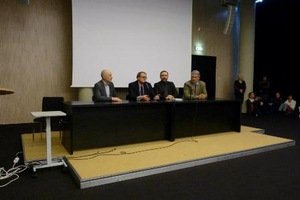L.DONSKIS OFFERS TO KNOW THE CULTURE OF THE OLD CONTINENT THROUGH THE LITTLE TOWNS 0
In brief: The academician and public figure Leonidas Donskis compares Europe to a necklace consisting of very different parts. In his newest book ‘The Little Europe: a Map of an Aesthete’ he offers to examine the small beads of the necklace – towns that sometimes are invisible aside the large culture and power centres.
The book is published in Lithuanian yet its topic oversteps the borders of countries and suggests looking at a varied beading of Europe as entity. The addressee of the book is also cosmopolitan: the author considers his journey descriptions the appeal of one European to another. A reader from Lithuania, which too belittles itself in Europe, is encouraged to feel as a small but valuable part of the necklace.
L. Donskis confessed a fatal love to art during the presentation of his book. He has been reading books of art history since his childhood, especially fascinated by the old Flemish and Dutch painting. Eventually the relationship became more and more serious. When Lithuania re-established its independence, the professor started to travel a lot and finally met the originals in museums.
His beloved little towns were related to painting because they used to be towns of painters – like Delft in the time of J. Vermeer. When one visits Salzburg, remembers Mozart; while Vienna is the city of Mozart, Haydn, Salieri, Schubert... Every cultural centre dictates own subjects and contexts.
The book could be published in other languages like Dutch or French but the author underlines the significance of the mother-tongue here. He finds the book very Lithuanian in several aspects. Firstly, he dedicates it to young people, pupils and students. Secondly, he himself is a Lithuanian, writing about Europe and offering the way how Lithuanians could see and discover themselves in Europe. Finally the book is related to the author’s past and rather intimate recollections thus oriented to the Lithuanian language.
When asked if the Lithuanian audience was cosmopolitan enough to appreciate the book, L. Donskis said he wrote it to bright, sensitive people: clever pupils and students, teachers, lecturers, intelligent people who had travelled, seen the world and perceived Europe as a correlative organism. Those who feel the thread beading Europe in spite of its deep cultural and verbal differences. Some call it Christianity, others – the experience of modernity and forms of sensitivity.
The book shows its author’s attempt to draw attention at things that are relevant but less visible. People do not question a wish to write about London, New York, Paris, Madrid or Rome. Yet Donskis wanted to write about little towns like Bruges or Gent, which used to be called the Flemish Manchester; or Cordoba, which was the biggest European city in the Middle Ages and which now is a little marvellous town in Spain. Small towns have their forms of greatness; the smallness is pronounced with love, admiration and respect. That is why the Little Europe is valuable for the author.
There are little towns in Lithuania itself that Donskis would love to describe: e.g. Švėkšna, Rusnė, Kėdainiai, Šilutė. The author would look at their beauty through the multicultural character of Lithuania. The small country had a lot of historical communities and cultures – Russian Old Believers, Jews, Tartars, Karaites. Lithuania gave great people to the world that were born in little Lithuanian towns. For instance, one of the most famous researchers of the Italian Renaissance, expert of painting Bernard Berenson was born in Butrimonys near Alytus.
‘The Little Europe’ is thread through the relationship with painting and history of Europe, showing that political power and wars walk in step with sensitivity and friendship. Spain and the Netherlands are in war yet Velazquez and Rubens are friends. Donskis is showing a wonderful paradox of Europe: important ideas can be created by people who come from hostile countries.









